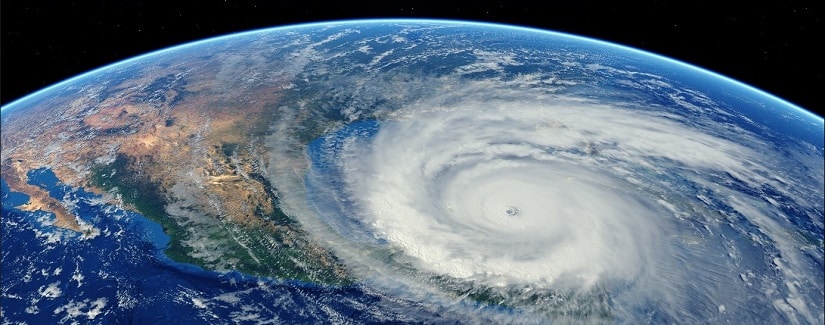Cristina Leon Vera | 22/04/2024
Hurricanes, earthquakes and storms damage geographical areas exposed to these types of extreme weather events each season. Strategic sectors work to protect infrastructure and the population, but how accurately can their impact be predicted?
The world is marked by the continuous intensification and wider reach of climate events, such as extreme heat waves, tropical storms or tsunamis, which impact both the well-being of citizens and the regional economic development. In this context, the ability to anticipate these phenomena is increasingly pressing to avoid consequences ranging from the loss of human lives to the destruction of essential infrastructure.
Bernat Jiménez Esteve, an Atmospheric Scientist at the Institute of Geosciences (IGEO), from the Superior Council of Scientific Research (CSIC), tells us about the technology trends that are addressing this important challenge.
Anticipation as a resource
“Progressing sub-seasonal predictability of extreme events is crucial for effective risk management, resource planning, rapid response, critical infrastructure protection, food security, public health, and climate change adaptation,” Bernat says.
Predicting these events allows authorities and communities to prepare ahead of time, reducing the impact in terms of human lives, property damage, and the disruption of essential services. Good management has a very positive impact on different aspects, including:
For citizens:
- It provides additional time to prepare for and take safety measures, such as early evacuations in the event of storms, thereby reducing the risk of loss of human property and lives.
- Enables resource planning, such as shelter evacuation or provisioning to stay home during a storm, increasing community responsiveness and resilience to extreme weather events.
For industries:
- A good prediction helps farmers make effective decisions about which crops to grow and when to do so, increasing crop sustainability and profitability.
- Implementing mitigation measures to protect crops from the negative effects of extreme events, such as floods or frost, strengthens food security.
- In the energy industry, technology facilitates better planning to manage energy demand during periods of extreme heat or intense cold, avoiding power outages and ensuring continuity of essential services.
The addition of new technologies
The specialist points out that there are several techniques and methods to predict extreme weather events more accurately, and in advance. “One of the most common methods at the sub-seasonal level is numerical prediction models. These use physics-based mathematical equations to simulate the atmosphere and other components of the climate system, such as the ocean, sea ice, or soil,” he says.
This implies that weather prediction varies depending on the time period considered. In the short term – up to about seven days – conditions are foreseeable, but uncertainty increases due to the chaotic nature of the atmosphere – the butterfly effect. On a seasonal scale, daily evolution can be unpredictable, but the average conditions of a station can be estimated using information from slower system components.
Bernat puts it as “one of the most notable recent advances in predicting extreme events, incorporating artificial intelligence techniques. For example, some models may already predict the likelihood of heat waves three weeks before they occur.”
Furthermore, the addition of AI offers substantial advantages in predicting extreme events such as:
- Improvement in numerical prediction models. This allows parameterizations of unresolved phenomena, such as cloud microphysics or irradiating processes to be addressed.
- Decrease of biases and uncertainties. Hybrid models offer significant potential by enabling better parameterization calibration.
- Optimizing assimilation of observations. AI ensures that accurate baseline and contour conditions are generated for models.
- Advanced data processing. This involves a more detailed and refined analysis of the results, making it easier to identify relevant patterns and trends.
- Flexibility and adaptability. This results in dynamic adjustment based on changing weather conditions and data availability.
A parameterized future
Jiménez Esteve highlights the success achieved in climate prediction by using the example of heat waves and their impact on public health. “The anticipation of these events and the development of action plans, arising from the devastating heat wave of 2003 in Europe, have contributed significantly to dramatically reducing the number of deaths,” he recalls.
However, it also warns of persistent challenges due to the low frequency and limited predictability of these phenomena. Although significant improvements have been made to numerical models, physical observations and parameters in recent decades maintain some technical and system understanding difficulties.
Yet he believes these challenges linked to technological progress will be overcome by unprecedented scientific collaboration that has already paid off. “In recent decades, there have been consistent advances in the expertise of these models through improvements in numerical methods, number and accuracy of observations, physical parameters, and spatial resolution of models,” he concludes.
Contributors to this article:

Bernat Jiménez Esteve is an atmospheric physicist who works as a postdoctoral researcher in atmospheric science at the Institute of Geosciences (IGEO), the only mixed research institution dependent on the Superior Council of Scientific Research (CSIC) and the Complutense University of Madrid (UCM).
He earned his bachelor’s degree in physics, and his master’s degree in meteorology from the University of Barcelona, and completed his PhD in Zurich.
Throughout his career, he has worked with global and regional atmospheric models, trying to understand the processes behind different weather phenomena.





